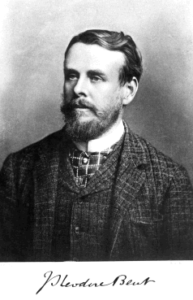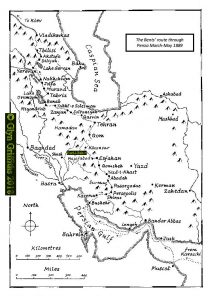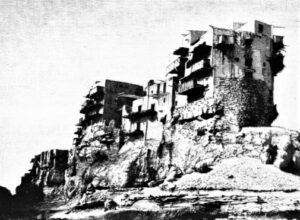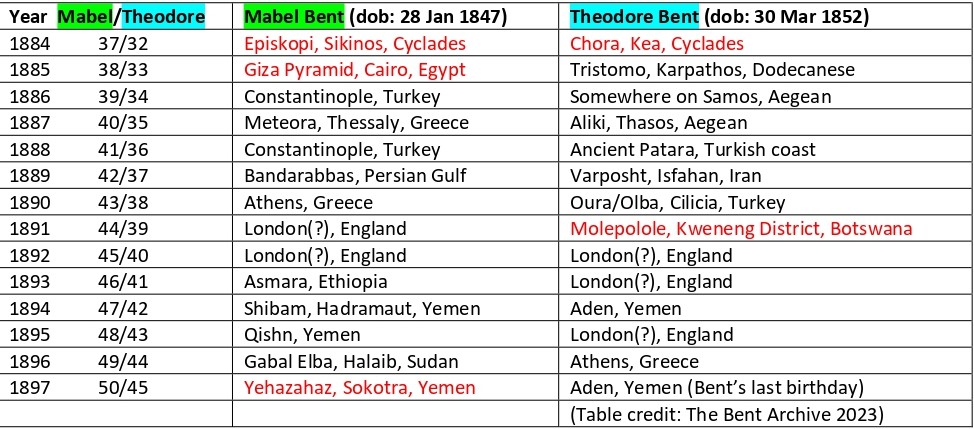
The trouble with travel is that you miss your birthdays – just look where Theodore was on 30 March for these frantic years of the Bents’ travels together: 1884 = Kea (Cyclades); 1885 = Karpathos (Dodecanese); 1886 = Samos; 1887 = Thasos; 1888 = Patara (Antalya province, Turkey); 1889 = Kurd-i-Bala, Iran; 1890 = Mersin area, Turkey; 1891 = en route for ‘Great Zimbabwe’; 1892 = UK; 1893 = Aksum area, Ethiopia; 1894 = Aden, Yemen; 1895 = UK; 1896 = returning from Athens to UK; 1897 (his 45th and last) = Aden, Yemen.
As an example of what he was up to, we have this extract from his notes of 30 March 1889, written up and presented a couple of years later. Taken from Theodore and Mabel’s cavalcade through Iran, south-north, we have Persia with all her fascination; it is written in his best, jaunty style: illustrative, informative, energetic, engaged and engaging. Classic Bent.

“Certainly, Persia, off the main line of route, is as different as possible from the Persia that the ordinary traveller sees. For two days after leaving Nejifabad we passed through villages nestling in fertility. Each village is, or rather was, protected by its mud fort, built on a hill, around which the cottages cluster – cottages which dazzle the eye with their continuity of mud domes and brown walls. Wapusht looked like a nest of cottage beehives stuck together. Within, the houses were comfortable enough, and bore every appearance of prosperity, for here they are off the routes which soldiers and governors of provinces pass over, and when free from Government extortions Persia prospers.
“On ascending to higher ground we came across a cold and barren district; the howling wind from the snow mountains made us again love those furs which we had considered unnecessary burdens when leaving Ispahan. These sudden changes of temperature are the bane of the Persian traveller, and woe to those who are not provided with artificial warmth. On reaching Kurd-i-Bala [March 30, 1899. The settlement is near modern Varposht, n-w of Najafabad], the first of the manna villages, we found ourselves in Armenian society. Of late years the Armenians in Persia, by foreign intervention, have had their condition greatly ameliorated, and if this state of things is allowed to continue they are likely once more to become the most prosperous of the Shah’s subjects. I was glad enough to warm myself by taking a brisk walk on reaching our destination, and accepted gladly the offices of the Karapiet, the Reis or headman of the village, and our host, who volunteered to take me up the mountain side and show me the manna shrub.
“In the fields around the village the Armenian women were tilling the ground. On their heads they wore tall head-dresses, with flat crowns and silver chains dangling therefrom – very uncomfortable gear for purposes of husbandry – and beneath their bright red skirts peeped drawers with embroidered edges. Armenian women hide only the lower part of the face, deeming it unseemly that the mouth should be shown to members of the opposite sex.

“Kurd-i-Bala is a great village for manna, the ‘gez-angebeen’, as the Persians call it. About twenty minutes’ walk brought us to a gorge in the mountains where acres of the shrub grow. The ‘gez’ tree is a low and parasol-shaped plant of the Tamarisk tribe, never reaching more than 3ft. in height; its leaves are small and sombre in colour, and it has all over it long prickly thorns. On these leaves there comes a small insect, which is red at first, like a harvest bug; later on it turns into a sort of louse, and finally becomes a tiny moth, which, before it flies off, produces a thin white thread, about half an inch long, which hangs on the bushes. This is the manna collectors shake off on to trays, which are put below for the purpose, and the material thus collected they call ‘gez’. They say the insect appears fifteen days before the hot weather begins, and disappears fifteen days before the cold season sets in. Every third day during a term of forty days about August they collect this species of honey from the trees, which forms itself into a white gelatinous mass, and the leaves become covered again with surprising rapidity…”
(From: J. Theodore Bent, Village Life in Persia, ‘The New Review’, 5:29 (1891/Oct.): 355-359)
Happy birthday Theodore!
A review of Bent birthdays based on Mabel Bent’s Chronicles, 1884-1897
The accompanying interactive map below plots these birthdays: Mabel in green, Theodore in blue. (NB: London [13 Great Cumberland Place] stands in for unknown locations in Great Britain; the couple could have been away visiting family and friends in Ireland or England, including at their property ‘Sutton Hall’, outside of Macclesfield.)

There were 28 Bent birthday events (2 x 14) between 1884–1897 (the years covered by Mabel Bent’s diaries). Of these 28, only 5 (18%) were not spent in the field, and only 7 times (25%) does Mabel refer to a birthday in her notebooks directly. In the above Table, column 1 gives the year and ages of the Bents on their birthdays; columns 2 and 3 give their birthday locations. Events in red are when Mabel refers directly to their birthdays. ‘London’ is standing in for unknown locations in Great Britain. If not at their main residence (13 Great Cumberland Place), the couple could have been visiting family and friends in Ireland and England, including at their property Sutton Hall, outside of Macclesfield.

 Leave a comment or contact us about this article
Leave a comment or contact us about this article
A fascinating post from one of the country’s greatest explorers who started out on his journey through life 166 years ago tomorrow. Happy birthday Theodore.